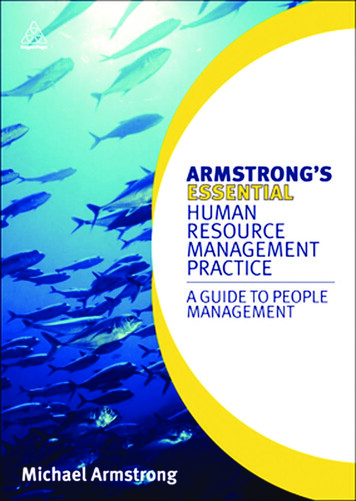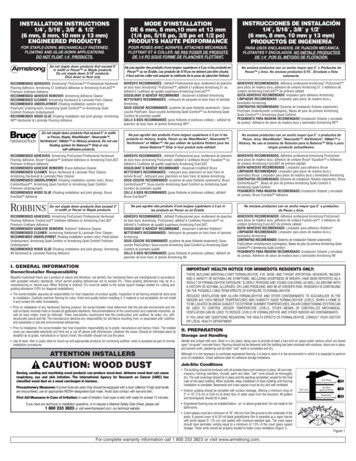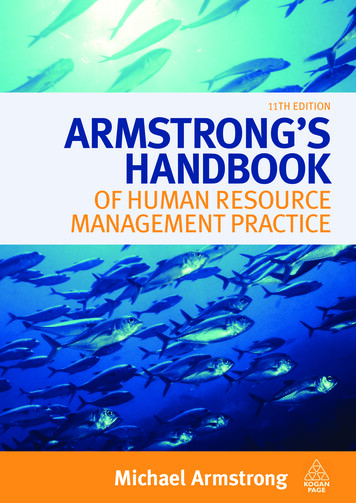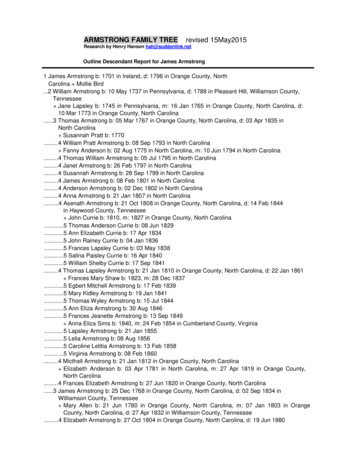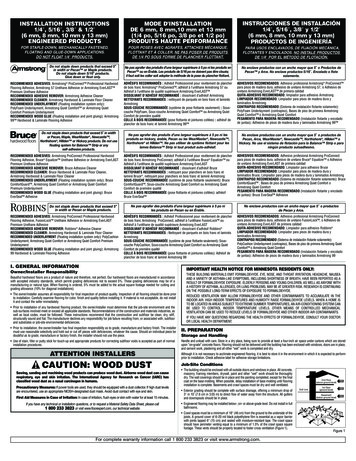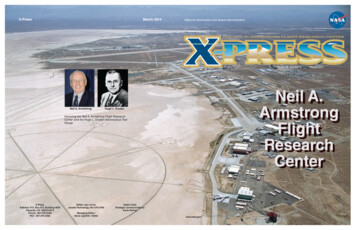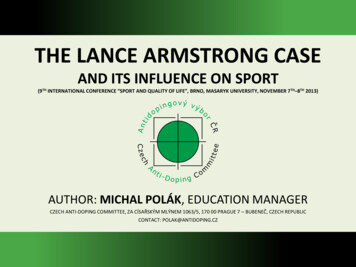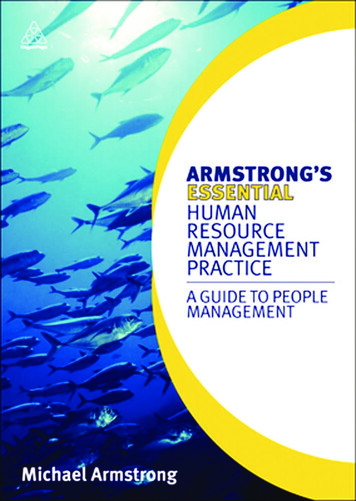
Transcription
iARMSTRONG’SESSENTIALHUMAN RESOURCEMANAGEMENT PRACTICE
iiTHIS PAGE IS INTENTIONALLY LEFT BLANK
iiiARMSTRONG’SESSENTIALHUMAN RESOURCEMANAGEMENT PRACTICEA GUIDE TO PEOPLEMANAGEMENTMichael Armstrong
ivPublisher’s noteEvery possible effort has been made to ensure that the information contained in this book is accurate at thetime of going to press, and the publishers and author cannot accept responsibility for any errors or omissions,however caused. No responsibility for loss or damage occasioned to any person acting, or refraining fromaction, as a result of the material in this publication can be accepted by the editor, the publisher or the author.First published in Great Britain and the United States in 2010 by Kogan Page LimitedApart from any fair dealing for the purposes of research or private study, or criticism or review, as permittedunder the Copyright, Designs and Patents Act 1988, this publication may only be reproduced, stored or transmitted, in any form or by any means, with the prior permission in writing of the publishers, or in the case ofreprographic reproduction in accordance with the terms and licences issued by the CLA. Enquiries concerningreproduction outside these terms should be sent to the publishers at the undermentioned addresses:120 Pentonville RoadLondon N1 9JNUnited Kingdomwww.koganpage.com525 South 4th Street, #241Philadelphia PA 19147USA4737/23 Ansari RoadDaryaganjNew Delhi 110002India Michael Armstrong, 2010The right of Michael Armstrong to be identified as the author of this work has been asserted by him in accordance with the Copyright, Designs and Patents Act 1988.ISBN978 0 7494 5989 5E-ISBN 978 0 7494 5990 1British Library Cataloguing-in-Publication DataA CIP record for this book is available from the British Library.Library of Congress Cataloging-in-Publication DataArmstrong, Michael, 1928–Armstrong’s essential human resource management practice : a guide to people management / MichaelArmstrong.p. cm.ISBN 978-0-7494-5989-5 — ISBN 978-0-7494-5990-1 (ebook) 1. Personnel management—Handbooks,manuals, etc. I. Title. II. Title: Essential human resource management practice.HF5549.17.A758 2010658.3—dc222010000341Typeset by Graphicraft Limited, Hong KongPrinted and bound in India by Replika Press Pvt Ltd
vContentsIntroduction1Part IHuman Resource Management5The Practice of Human Resource Management71.Introduction 8; The philosophy of HRM 8; The purpose of HRM 9;The diversity of HRM 10; HRM as a system 11; The context of HRM 12;The ethical dimension 14; The impact of HRM on performance 15;The HRM role of line managers 15; The role of the HR function 19;The role of HR practitioners 21; Critical evaluation of the concept ofHRM 28; Key learning points 30; Questions 31; References 312.Strategic Human Resource Management34Introduction 35; The conceptual basis of strategic HRM 35; StrategicHRM defined 37; The resource-based view of strategic HRM 39;Strategic fit 41; Perspectives on strategic HRM 41; HR strategies 47;Critical evaluation of the concept of strategic HRM 50; Key learningpoints 52; Questions 54; References 543.HR Policies and Procedures57Introduction 57; HR policies 57; HR procedures 66; Key learning points 69;Questions 70; References 704.Human Capital Management71Introduction 72; Human capital management defined 72; The conceptof human capital 72; Human capital measurement 74; Human capitalreporting 80; Key learning points 81; Questions 82; References 835.Knowledge ManagementIntroduction 84; Knowledge management defined 85; The concept ofknowledge 86; The purpose and significance of knowledge management 87;Knowledge management strategies 87; Knowledge management systems 88;Knowledge management issues 90; Key learning points 91; Questions 93;References 9384
Contentsvi6.Corporate Social Responsibility95Introduction 95; Strategic CSR defined 96; CSR activities 96; The rationalefor CSR 98; Developing a CSR strategy 99; Key learning points 100;Questions 100; References 1017.International HRM103Introduction 103; International HRM defined 104; Issues in internationalHRM 104; Global HR policies and practices 109; Managing expatriates 109;Key learning points 114; Questions 116; References 116Part IIOrganizations and People1198.Organizational Behaviour121Introduction 122; Organizational behaviour defined 122; The sources andapplications of organizational behaviour theory 122; How organizationsfunction 123; Organizational processes 126; Organizational culture 128;Organization design 129; Characteristics of people 130; Motivation 136;The psychological contract 144; Organization development 146; Keylearning points 147; Questions 149; References 1509.Employee Engagement153Introduction 153; The meaning of employee engagement 154; Discretionarybehaviour 157; Why engagement is important 158; Drivers of engagement 158;Enhancing engagement 159; Enhancing organizational engagement 163; Keylearning points 165; Questions 165; References 165Part III10.HRM Practice167Competency-based HRM169Introduction 170; Types of competencies 170; Competency frameworks 171;Applications of competency-based HRM 171; Behavioural competencymodelling 174; Keys to success in using competencies 175; Key learningpoints 175; Questions 176; References 17711.Job and Role Analysis and Design178Introduction 179; Job and role analysis 179; Job design 181; Roledevelopment 183; Key learning points 183; Questions 184; References 18512.People ResourcingIntroduction 187; People resourcing strategy 187; Human resourceplanning 189; Recruitment and selection 192; Selection methods 195;186
Contents viiRetention planning 198; Talent management 203; Flexibility planning 208;Absence management 210; Key learning points 212; Questions 213;References 21413.Learning and Development216Introduction 217; Learning and development defined 217; Learningand development strategy 219; Learning culture 219; The learningorganization 220; Organizational learning 221; How people learn 223;Approaches to learning and development 226; Development 228;Training 230; Blended learning 232; Planning and delivering learningprogrammes and events 232; Identifying learning needs 235; Evaluationof learning 238; Management and leadership development 239; Keylearning points 242; Questions 244; References 24414.Managing Performance246Introduction 247; The meaning of performance 247; Influences onperformance 248; High-performance cultures 250; High-performancework systems 251; Managing organizational performance 253; Managingteam performance 257; Managing individual performance 259;Key learning points 262; Questions 263; References 26315.Reward Management266Introduction 267; Reward management defined 267; Aims of rewardmanagement 267; The reward management framework 268; The rewardpackage 268; Reward systems 268; Strategic reward 271; Total rewards 273;Financial rewards 275; Non-financial rewards 279; Job evaluation 279;Market pricing 281; Grade and pay structures 282; Pay progression 287;Recognition schemes 289; Employee benefits 289; Key learning points 289;Questions 291; References 29116.Employee Relations293Introduction 294; The employment relationship 294; Underpinningemployment relations philosophies 297; Employee relations policies 298;Managing employee relations 299; Collective bargaining 301; Collectiveagreements 302; Dispute resolution 304; Employee voice 305;Communications 307; Key learning points 308; Questions 310;References 31017.Employee Well-beingIntroduction 313; Managing the work environment 313; Health and safetymanagement 315; Key learning points 320; Questions 322; References 322312
ContentsviiiPart IV18.People Management Skills323Managing Change325Introduction 325; The change process 325; Change models 326; Resistanceto change 327; Implementing change 329; Guidelines for changemanagement 329; References 33019.Leadership Skills331What leadership involves 331; Leaders and followers 333; Ulrich’sleadership brand 333; Leadership styles 334; What makes a goodleader 335; Leadership and emotional intelligence 335; Developingleadership skills 336; References 33820.Selection Interviewing Skills339The nature of a selection interview 339; The content of an interview 340;Preparing for the interview 341; Planning the interview 342; Interviewingtechniques – asking questions 343; Key interviewing skills 349; Comingto a conclusion 35121.Performance Management Skills354Setting objectives 354; Formal review meetings 357; Guidelines onproviding feedback 36122.Learning and Development Skills364Induction training 364; Continuous learning 364; Personal developmentplanning 365; Coaching 366; Mentoring 367; Job instruction 36823.Managing Conflict370Introduction 370; Managing inter-group conflict 370; Managing conflictbetween individuals 371; The role of the third party in managingconflict 373; Conclusion 374; References 37524.Handling People Problems376Absenteeism 376; Disciplinary issues 378; Negative behaviour 380; Poortimekeeping 384; Underperformance 385Appendix: HRM Research Methods386Author indexSubject index410415This book is accompanied by additional online material. To access these resources go towww.koganpage.com/resources and under ‘Academic Resources’ click on either ‘StudentResources’ or ‘Lecturer Resources’ as appropriate.
1IntroductionThis book describes the essential features of human resource management (HRM). The aim isto provide practitioners and students with a succinct picture of the key processes and activitiesinvolved in managing people. The practical approaches to HRM described in the book arebacked up with evidence from research. Critical evaluations are included for the following keyHRM theories and concepts:zz HRM itself;zz the role of HR business partner;zz strategy;zz strategic HRM;zz the resource-based view;zz the choice between best practice and best fit;zz bundling;zz human capital measurement;zz motivation theory;zz emotional intelligence;zz the flexible firm;zz the learning organization;zz financial rewards.Underpinning philosophyThe philosophy underpinning this book was well-expressed by Schneider (1987). He wrote that:‘Organizations are the people in them people make the place.’ His point was that:
2IntroductionAttraction to an organization, selection by it, and attrition from it yield particular kindsof persons in an organization. These people determine organizational behaviour Positive job attitudes for workers in an organization can be expected when the naturalinclinations of the persons there are allowed to be reflected in their behaviours by thekinds of processes and structures that have evolved there.HRM has to serve the interests of the business but it must also be concerned with the interestsof the people in the business. A stakeholder approach is adopted throughout the book. Inaccordance with the views of Freeman (1984), management, and this includes HR specialists,must satisfy a variety of constituents comprising employees, customers and the community atlarge as well as shareholders or, in the public or voluntary sectors, those who have the ultimateresponsibility for what the organization does.There is an important ethical dimension to HRM. As Boxall et al (2007) point out: ‘WhileHRM does need to support commercial outcomes (often called “the business case”), it alsoexists to serve organizational needs for social legitimacy.’ This means exercising social responsibility, or in other words being concerned for the interests (well-being) of employees andacting ethically with regard to the needs of people in the organization and the community.Plan of the bookThe book is dived into four Parts and an Appendix.Part IHuman Resource ManagementPart I deals with the fundamentals of HRM. It starts with a general review of the practice ofHRM. It continues with a description of the processes that provide guidelines on the direction,scope and application of HRM, namely strategic HRM and HR policies and procedures. Theneed to base HRM decisions on data and information relating to the use and development of theorganization’s human capital is dealt with in Chapter 4, and the associated topic of knowledgemanagement – increasing organizational capability by sharing the wisdom, understanding andexpertise accumulated in a business about its processes, techniques and operations – is coveredin Chapter 5. The requirement for organizations to conduct their business in an ethical way,taking account of the social, environmental and economic impact of how they operate, andgoing beyond compliance, is emphasized in Chapter 6. The final chapter of Part 1 recognizesthat organizations operate in a global context, and explores the particular factors that affectinternational HRM.
IntroductionPart II3Organizations and peoplePart II recognizes that HRM takes place within the context of organizations, in which the waypeople behave and how the organizations of which they are members function will governHRM policy and practice. It also deals with the concept of employee engagement, which isbecoming increasingly prominent in people management, but which is often presented asa mantra without being properly understood. Chapter 9 examines the concept in detail byreference to recent research.Part IIIHRM practiceThis is the heart of the book. It deals with:zz the basic HRM activities of competency-based HRM, job / role analysis and design;zz people resourcing;zz learning and development;zz managing performance;zz reward management;zz employee relations;zz providing for the well-being of employees.Part IV People management skillsThe activities described in Part IV all require people management skills from line managers aswell as HR specialists. The following skills are covered in this part:zz managing change;zz leadership;zz selection interviewing;zz performance management;zz learning and development;zz managing conflict;zz handling people problems.AppendixHRM research methodsThis appendix describes the approaches and techniques used in conducting HRM researchprojects.
4IntroductionReferencesBoxall, P F, Purcell, J and Wright, P (2007) The goals of HRM, in Oxford Handbook of Human ResourceManagement, ed P Boxall, J Purcell and P Wright, Oxford University Press, OxfordFreeman, R E (1984) Strategic Management: A stakeholder perspective, Prentice Hall, Englewood Cliffs,New JerseySchneider, B (1987) The people make the place, Personnel Psychology, 40 (2), pp 437– 53
5Part IHuman ResourceManagement
6THIS PAGE IS INTENTIONALLY LEFT BLANK
71The Practice ofHuman Resource ManagementKey concepts and termszz Business partnerzz HR strategieszz Centre of expertisezz HR systemzz Commitmentzz Human resource managementzz Contingency theoryzz Humanismzz Hard HRMzz Mutualityzz HR philosophyzz Organizational capabilityzz HR policieszz Shared service centrezz HR practiceszz Soft HRMzz HR processeszz Strategic business partnerzz HR programmeszz Strategic integrationLearning outcomesOn completing this chapter you should be able to define these key concepts. You shouldalso understand:zz The meaning and aims of humanresource management (HRM)zz That HRM in practice is highlydiversezz How HRM functions as a systemzz The ethical dimension of HRMzz The impact of HRM on performancezz The HRM role of line managerszz The role of the HR function
8Human Resource ManagementIntroductionThe practice of Human Resource Management (HRM) is concerned with all aspects of howpeople are employed and managed in organizations. It covers activities such as:zz strategic HRM;zz human capital management;zz knowledge management;zz organization development;zz resourcing (human resource planning, recruitment and selection, and talentmanagement);zz performance management;zz learning and development;zz reward managementzz employee relations;zz employee well-being.HRM can be described as a strategic, integrated and coherent approach to the employment,development and well-being of the people working in organizations. It has a strong conceptualbasis drawn from the behavioural sciences and from strategic management, human capital andindustrial relations theories. This foundation has been built with the help of a multitude ofresearch projects.The aims of this chapter are to provide a general introduction to the practice and underpinningconcepts of HRM and to outline the HRM roles of line managers and the Human Resources(HR) function.The philosophy of HRMAs originally conceived by the pioneers in the 1980s, the concept of HRM was based on aphilosophy which was fundamentally different from the personnel management practices ofthe time. Beer et al (1984) believed that ‘Today, many pressures are demanding a broader,more comprehensive and more strategic perspective with regard to the organization’s humanresources These pressures have created a need for a longer-term perspective in managingpeople and consideration of people as potential assets rather than merely a variable cost.’Beer and his colleagues (the Harvard school) were the first to underline the HRM tenet thatit belongs to line managers. They suggested that HRM has two characteristic features, first,
The Practice of Human Resource Management9that line managers accept more responsibility for ensuring the alignment of competitivestrategy and HR policies, and second, that HR has the mission of setting policies that governhow HR activities are developed and implemented in ways that make them more mutuallyreinforcing.Fombrum et al (1984) held that HR systems and the organization structure should be managedin a way that is congruent with organizational strategy.A full explanation of HRM philosophy by Legge (1989) stated that HRM consists of the following propositions:That human resource policies should be integrated with strategic business planning andused to reinforce an appropriate (or change an inappropriate) organizational culture,that human resources are valuable and a source of competitive advantage, that theymay be tapped most effectively by mutually consistent policies that promote commitment and which, as a consequence, foster a willingness in employees to act flexibly inthe interests of the ‘adaptive organization’s’ pursuit of excellence.The philosophy underpinning this notion of HRM provided a new vision which was stronglycriticized by many commentators during the 1990s (see the critical evaluation of HRM at theend of this chapter). It was supposed to be substantially different from old-fashioned personnelmanagement, a term which has virtually disappeared since then, although in some quarters theterm ‘people management’ has been adopted, possibly by those who dislike the connotations of‘human resources’ with its apparent emphasis on exploitation and treating people as factors ofproduction. However, whether it is called human resource management or people management, the essential nature of the ways in which organizations manage and relate to theiremployees has not always changed significantly from that of personnel management, althoughnew techniques may have been introduced. In 2000 I asked the question ‘The name has changedbut has the game remained the same?’ and answered it with a broad affirmative.A more recent and less philosophical reference to HRM was made by Boxall et al (2007), whodefined it as ‘The management of work and people towards desired ends.’The purpose of HRMThe overall purpose of HRM (or people management) is to ensure that the organization is ableto achieve success through people. HRM aims to increase organizational effectiveness andcapability – the capacity of an organization to achieve its goals by making the best use of theresources available to it. Ulrich and Lake (1990) remarked that ‘HRM systems can be the sourceof organizational capabilities that allow firms to learn and capitalize on new opportunities.’ Thefollowing policy goals for HRM were suggested by David Guest.
Human Resource Management10Policy goals of HRM1.Strategic integration: the ability of the organization to integrate HRM issues into itsstrategic plans, ensure that the various aspects of HRM cohere, and provide for linemanagers to incorporate an HRM perspective into their decision making.2.High commitment: behavioural commitment to pursue agreed goals, andattitudinal commitment reflected in a strong identification with the enterprise.3.High quality: this refers to all aspects of managerial behaviour which bear directlyon the quality of goods and services provided, including the management ofemployees and investment in high-quality employees.4.Flexibility: functional flexibility and the existence of an adaptable organizationstructure with the capacity to manage innovation.Source: Guest (1991).The policy goals for HRM identified by Caldwell (2001) included managing people as assetswhich are fundamental to the competitive advantage of the organization, aligning HRM policies with business policies and corporate strategy, and developing a close fit of HR policies,procedures and systems with one another.HRM also has an ethical dimension, which means that it expresses its concern for the rightsand needs of people in organizations through the exercise of social responsibility.The diversity of HRMThere are no universal characteristics of HRM. Many models exist, and practices withindifferent organizations are diverse, often only corresponding to the conceptual version of HRMin a few respects. Boxall et al (2007) remarked that ‘Human resource management covers avast array of activities and shows a huge range of variations across occupations, organizationallevels, business units, firms, industries and societies.’A distinction was made by Storey (1989) between the ‘hard’ and ‘soft’ versions of HRM.The hard version of HRM emphasizes that people are important resources through whichorganizations achieve competitive advantage. These resources have therefore to be acquired,developed and deployed in ways that will benefit the organization. The focus is on the quantitative, calculative and business-strategic aspects of managing human resources in as ‘rational’ away as for any other economic factor.
The Practice of Human Resource Management11The soft version of HRM has its roots in humanism – an approach devoted to human interestswhich views people as responsible and progressive beings. It also trace its origins to the humanrelations school, as founded by Elton Mayo (1933), which believed that productivity wasdirectly related to job satisfaction and that the output of people will be high if they like theirco-workers and are given pleasant supervision. But this is a fairly remote connection. SoftHRM as described by Storey (1989) involves ‘treating employees as valued assets, a source ofcompetitive advantage through their commitment, adaptability and high quality (of skills, performance and so on)’. The emphasis is on the need to gain the commitment – the ‘hearts andminds’ – of employees through involvement, communications, leadership and other methodsof developing a high-commitment, high-trust organization. It was advocated by, among others,Walton (1985), who focused attention on his principle of ‘mutuality’ (a state that exists whenmanagement and employees are interdependent and both benefit from this interdependency)and the move from control to commitment. Attention is also drawn to the key role of organ izational culture.It has, however, been observed by Truss (1999) that ‘even if the rhetoric of HRM is soft, thereality is often hard, with the interests of the organization prevailing over those of the individual’. And research carried out by Gratton et al (1999) found that in the eight organizationsthey studied, a mixture of hard and soft HRM approaches was identified. This suggested to theresearchers that the distinction between hard and soft HRM was not as precise as some commentators have implied.But as Dyer and Holder (1998) emphasized, ‘HRM goals vary according to competitive choices,technologies or service tangibles, characteristics of their employees (eg could be different formanagers), the state of the labour market and the societal regulations and national culture’, andBoxall et al (2007) noted that ‘The general motives of HRM are multiple.’HRM as a systemIn its traditional form, HRM, as pointed out by Boselie et al (2005), can be viewed as ‘a collection of multiple discrete practices with no explicit or discernible link between them’. In contrast‘the more strategically minded systems approach views HRM as an integrated and coherentbundle of mutually reinforcing practices’. Kepes and Delery (2007) comment that a definingcharacteristic of HRM is that HRM systems and not individual HRM practices are the sourceof competitive advantage: ‘Coherent and internally aligned systems form powerful connectionsthat create positive synergistic effects on organizational outcomes.’As illustrated in Figure 1.1, an HRM system brings together HR philosophies which describethe overarching values and guiding principles adopted in managing people, HR strategieswhich define the direction in which HRM intends to go, HR policies which provide guidelinesdefining how these values, principles and strategies should be applied and implemented in
12Human Resource ManagementHUMAN RESOURCEMANAGEMENTHR philosophiesHuman capitalmanagementHR strategies, policies, processes,practices and programmesCorporate socialresponsibilityOrganizationResourcingLearning ignHuman resourceplanningOrganizationallearningJob evaluation/market surveysIndustrialrelationsDevelopmentRecruitment &selectionIndividuallearningGrade and gementManagementdevelopmentContingentpayHealth oyeewell-beingKnowledgemanagementCommunicationsHR servicesFigure 1.1The HRM systemspecific areas of HRM, HR processes which comprise the formal procedures and methods usedto put HR strategic plans and policies into effect, linked HR practices which consist of theapproaches used in managing people, and HR programmes which enable HR strategies,policies and practices to be implemented according to plan.The context of HRMHRM processes take place within the context of the internal and external environments ofthe organization. In line with contingency theory, these exert considerable influence on thedecision over which HR practices are adopted.
The Practice of Human Resource Management13The external environmentThe external environment consists of social, political, legal and economic developments andcompetitive pressures. Global competition in mature production and service sectors is increasing. This is assisted by easily transferable technology and reductions in international tradebarriers. Customers are demanding more as new standards are reached through internationalcompetition. Organizations are reacting to this competition by becoming ‘customer focused’,speeding up response times, emphasizing quality and continuous improvement, acceleratingthe introduction of new technology, operating more flexibly and ‘losing cost’. The pressure hasbeen for businesses to become ‘lean and mean’, downsizing and cutting out layers of management and supervision. They reduce permanent staff to a core of essential workers, increase theuse of peripheral workers (subcontractors, temporary staff ) and ‘outsource’ work to externalservice providers. These pressures can be considerable in an economic downturn such as theone beginning in 2008.The internal environmentThe following aspects of the internal environment will affect HR policy and practice:zz the type of business or organization – private, public or voluntary sector; manufacturingor service;zz the size of the organization;zz the age or maturity of the organization;zz the technology or key activities of the business will determine how work is organized,managed and carried out;zz the type of people employed, such as professional staff, knowledge workers, technicians,administrators, production workers, and sales and customer service staff;zz the financial circumstances of the organization, especially in economic downturns;zz the organization’s culture – the established pattern of values, norms, beliefs, attitudes andassumptions which shape the ways in which people behave and things get done;zz the political and social climate.Contingency theoryContingency theory tells us that definitions of HR aims, policies and strategies, lists of activities,and analyses of the HRM roles of line managers and the role of the HR function are valid onlyif they are related to the situation of the organization in its environment. Karen Legge (1978)in her influential book Power, Innovation and Problem Solving in Personnel Management was
14Human Resource Managementthe first commentator to insist that a contingent approach should be adopted: that is, ‘the designand implementation of policy that matches, or is contingent upon specified organizationalrequirements and circumstances’.As Paauwe (2004) explained, ‘Contingency theory states that the relationship between therelevant independent variables (eg HRM policies and practices) and the dependent variable(performance) will vary according to the influences such as company size, age and technology,capital intensity, degree of unionization, industry / sector ownership and location.’Contingency theory is associated with the concept of fit – the need to achieve congruencebetween an organization’s HR strategies, policies and practices, and its business strategies,within the context of its external and internal environment.The ethical dimensionAs Boxall et al (2007) point out, ‘While HRM does need to support commercial outcomes (oftencalled “the business case”), it also exists to serve organizational needs for social legitimacy.’ Thismeans exercising social responsibility, or in other words being concerned for the interests(well-being) of employees and acting ethically with regard to the
Armstrong's essential human resource management practice : a guide to people management / Michael Armstrong. p. cm. ISBN 978--7494-5989-5 — ISBN 978--7494-5990-1 (ebook) 1. Personnel management—Handbooks, manuals, etc. I. Title. II. Title: Essential human resource management practice. HF5549.17.A758 2010 658.3—dc22 2010000341
